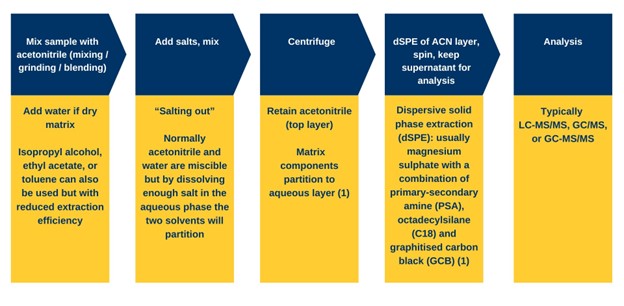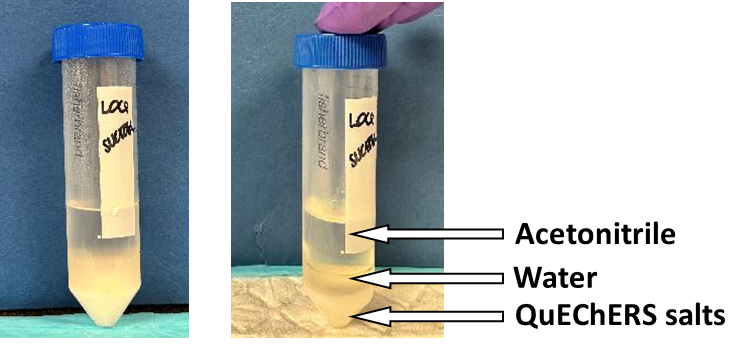In this second of a four-part series, Smithers Study Director, Sidney Bluemink, discusses the method and application of QuEChERS.
Part 1 discusses the wide-ranging application of QuEChERS and its variants.
QuEChERS
The simplified sample workup of QuEChERS will often be less selective compared to traditional methods, however improvements in analytical instruments have focused on refining the ability to select the analyte above background noise – elevating the applicability of the method. As a consequence, analysis methods often do not require as extensive workup as was the norm with older instruments and this is where QuEChERS comes into its own.
A typical QuEChERS method workflow comprises the following steps:


The QuEChERS approach provides many benefits to analytical methods. The
simplified and standardized approach, while also being flexible enough to provide options to maximize extraction efficiency, provides a regular starting point for extractions. This can save time and resources during method development and validation. QuEChERS uses
lower quantities of materials, a significant resource saving compared to other commonly used methods while also its streamlined workflow offers
high sample throughput in less time and reduced cost. The methodology is
very fast, enabling a quick turnaround of results. Based on its simplicity and uniformity, QuEChERS extractions are
less prone to systematic and random errors. Finally, the whole extraction process is
amenable to automation, providing further opportunities for cost savings and increased throughput.
While QuEChERS has many benefits, there can be some downsides to the approach, mostly as consequences of the uniform approach. As might be expected,
selectivity of the extraction is not always as effective as traditional, more iterative methods. The more
advanced instrumentation that are usually required for QuEChERS to be successful can be expensive to purchase and maintain. As the extraction solvent volume is limited, there can be reductions in
extraction efficiency and total residue recovery methods can be
challenging to transfer using QuEChERS analysis.
The use of
isotopically labeled internal standards can be required to compensate for analytical errors. These are not always readily available depending on the analyte(s) and can be expensive to obtain. QuEChERS methodology does not cover the entire range of pesticides that are currently typically tested.
Highly polar compounds such as chlormequat, glyphosate and fosetyl are difficult to analyze with a traditional QuEChERS approach as they fail to partition effectively into the organic phase. In addition,
lipophilic analytes can be difficult to extract from fatty matrices – especially important to consider for animal residue feeding studies or high oil content commodities.
These issues, while certainly not trivial, can be mitigated or worked around:

The core QuEChERS method is a simultaneously standardized and flexible approach to the efficient extraction of analytes from a range of biological samples.
In the next article, Sidney will review the QuEChERSER (Quick, Easy, Cheap, Effective, Rugged, Safe, Efficient and Robust) variant, or “Mega-Method” that extends extraction efficiency to lipophilic analytes from fatty matrices. Part 1 in this series covered the wide-raging application of QuEChERS and its variants.
.jpg) Author:
Author:
Sidney Bluemink
Study Director
Harrogate, UK
References
1. QuEChERS: Home (www.quechers.eu)




.jpg) Author:
Author: